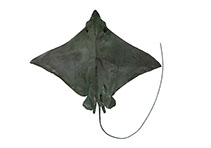| Family: |
Aetobatidae (Pacific eagle rays) |
| Max. size: |
100 cm WD (male/unsexed); 150 cm WD (female); max.weight: 14 kg; max.weight: 50 kg |
| Environment: |
benthopelagic; marine |
| Distribution: |
Northwest Pacific: eastern Vietnam, Hong Kong, China, Korea and southern Japan. |
| Diagnosis: |
This medium to large-sized Aetobatus (reaching 150 cm DW) possess the following diagnostic characters: uniformly greenish grey to brownish dorsal surfaces, without pale spots or ocelli; long head, ventral length 27.4-31.9% DW; long to very long rostral lobe (longest in adult males) and narrow, tapering evenly to tip; single row of teeth plates, those in lower jaw chevron-shaped; width of lower tooth plate about 2.4 times its width and in about 18 series; 100-104 pectoral-fin radials (excluding propterygial radials anterior of eyes); 88-90 total vertebral centra (including synarcual); pelvic-fin radials 1 (with 2-5 fused elements) +17-18; males mature by about 80 cm DW; born at 33.4-35.2 cm DW (Ref. 94821). |
| Biology: |
Found in shallow waters at water temperature above 15-17°C; in winter months, the species leave the shallower bays for nearby sea where water temperature is above 15°C brought by the Kuroshio current-derived warm waters (Ref. 94821). |
| IUCN Red List Status: |
Vulnerable (VU); Date assessed: 27 August 2019 (A2d) Ref. (130435)
|
| Threat to humans: |
harmless |
Source and more info: www.fishbase.org. For personal, classroom, and other internal use only. Not for publication.

